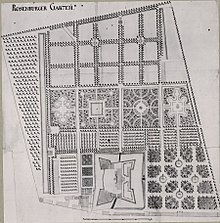Kongens Have
Coordinates: 55 ° 41 ′ 6.5 ″ N , 12 ° 34 ′ 48 ″ E
Kongens Have ( King's Garden ) is a green space in the center of Copenhagen .
The garden was created from 1606 on the initiative of the Danish King Christian IV. It initially served as a riding and pleasure garden as well as an orchard and kitchen garden for the royal court. Two of the main paths ( Kavalergangen and Damgangen ) and the open space of the former parade ground date from this early period . At first, Kongens Have was surrounded by a simple wooden fence.
The orangery and a garden pavilion have been preserved from the baroque garden: the orangery was temporarily converted into a barracks for the life guards; the Hercules pavilion was given its present form in 1773 by the architect Caspar Frederik Harsdorff . In the following years the baroque beds were redesigned in the spirit of the English landscape gardens . In the 19th century, a rose garden was created, crocuses were planted and the perennial beds were planted on the northern edge of the park. The reformer Johann Friedrich Struensee made the park temporarily open to the public in 1771/72, but it was not until 1819 that the general public was granted permanent access.
Harsdorff's Hercules Pavilion turns its classicist, column- adorned front side towards the Lindenallee Kavalergang ; the back, however, consists of simple half-timbering .
Today Kongens Have has no public access to Rosenborg Castle , which was built in the garden between 1613 and 1634.
Sculpture jewelry
Kongens Have adorn numerous sculptures. At the main entrance on the corner of Gothersgade and Kronprinsessegade ( Kongeporten ) stands the monument to the liberal reform politician Viggo Hørup, created in 1908 by Jens Ferdinand Willumsen . Hørup had succeeded in opening the King's Portal to everyone and made the park the crowd-puller that it has remained to this day. Kongens Have is particularly popular with Copenhageners and tourists in summer.
Peter Husum's bronze sculpture “Lion and Horse” (1624) was ridiculed for its weakness of expression, but at the time it was welcomed as a symbol for the primacy of the Danish lion (King Christian IV) over the Lüneburg stallion ( Prince Christian von Lüneburg ). Vilhelm Bissen's statue of the charitable Queen Caroline Amalie (1896) also attracted ridicule. Popularly known as the "tea warmer", it is a striking illustration of the crinoline fashion of the time .
literature
- Rudolf Broby-Johansen: Med Borby i det gamle København indenfor voldene , Copenhagen 1986, pp. 78-82.
Web links
- Kongens Have Slots- og Kulturstyrelsen (Danish)


